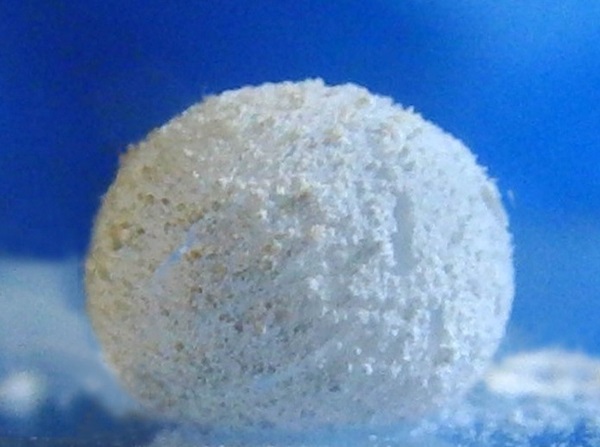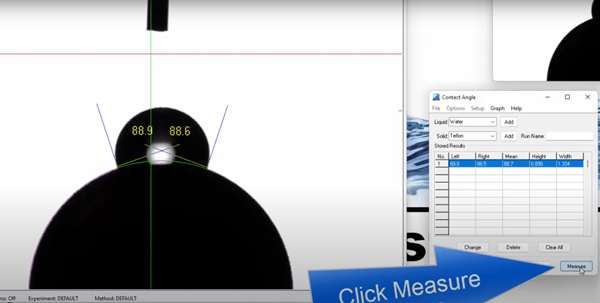|
June
2024 |
| What is a Liquid Marble? |
|
A liquid marble is a droplet of liquid coated with hydrophobic (or sometimes superhydrophobic) particles, forming a non-wetting surface around the liquid. The particles adhere to the liquid interface, creating a protective shell that prevents the liquid from wetting the underlying surface. The adhesion of the particles to the liquid interface is primarily driven by surface tension and intermolecular forces.
The hydrophobic particles prevent the liquid inside the from wetting external surfaces, making the marble behave like a solid in terms of mobility. The particle shell provides structural integrity, allowing the marble to maintain its shape and resist coalescence with other liquid marbles. Depending on the particle type and coating density, liquid marbles can exhibit elastic properties, allowing them to deform under pressure and return to their original shape - much like a balloon. The liquid marble exhibits extremely low adhesion to surfaces due to the hydrophobic shell, leading to high mobility. Liquid marbles can float on liquid surfaces without merging, maintaining their structure due to the particle layer. Liquid marbles have a variety of useful applications. For example, they can be used as microreactors for chemical reactions and biological assays, providing a confined environment for small-scale processes.1 Their unique properties also make them useful in creating sensors and diagnostic tools that require minimal sample volumes.2 They also offer a potential use in drug delivery systems where controlled release and targeted delivery are key.3 Liquid marbles have unique mechanical properties, such as deformability and mobility, making them suitable for use in soft robotics and actuation systems.4 There are myriad other applications and potential applications for the unique phenomenon known as the liquid marble. Liquid marbles represent a fascinating intersection of liquid dynamics, surface chemistry, and material science. Their formation, stability, and unique wetting properties have opened new doors for research and applications in various scientific and industrial fields. By encapsulating a liquid with hydrophobic particles, liquid marbles exhibit non-wetting behavior and enhanced mechanical properties, making them valuable for innovative technologies and fundamental studies of wetting phenomena. Notes |
| How to Measure the Contact Angle of a Liquid Marble using a ramé-hart Goniometer |
|
There are several methods available for assessing the physical properties and behavior of a liquid marble. For measuring wetting properties, contact angle goniometry is used. Here is an overview of the steps required to measure the contact angle of a liquid on a liquid marble. Note that for this procedure, the liquid marble behaves and is treated as a solid. 1. Prepare a liquid marble
ensuring that it's fully coated with the hydrophobic particles. Note:
You will need any calibrated ramé-hart instrument that is equipped with
a recent version of DROPimage Advanced software (v3.23.2.0 or higher).
It's that easy. In addition to the static contact angle, you can also add and remove volume from the drop to capture both the advancing and receding contact angle.2 Notes |
| Product of the Month |
|
Our product of the month is DROPimage Advanced. This is our premier edition of DROPimage software. It ships with our Models 250, 260, 500, 590, and is available as an upgrade to users of DROPimage Pro, DROPimage Standard, and DROPimage CA. In addition to a powerful Contact Angle Tool (discussed in the article above), DROPimage Advanced also features a robust methods-based experiment design tool which controls the parameters, method, time instructions, phase data, and events that dictate the experiment instructions. This tool is particularly powerful for creating time-dependent and dynamic studies for contact angle, surface tension, interfacial tension, and even tilting experiments using the optional ramé-hart Automated Tilting Base hardware. But despite its sophistication, it's easy to use - especially with the included Experiment Wizard tool. To learn more about DROPimage Advanced, please visit this page and watch this introductory video. And for a complete collection of over three dozen videos showing DROPimage Advanced in action, check out this playlist. Feel free to contact us if you're looking for a new instrument or are interested in upgrading to DROPimage Advanced. |
|
Regards,
Carl Clegg |


